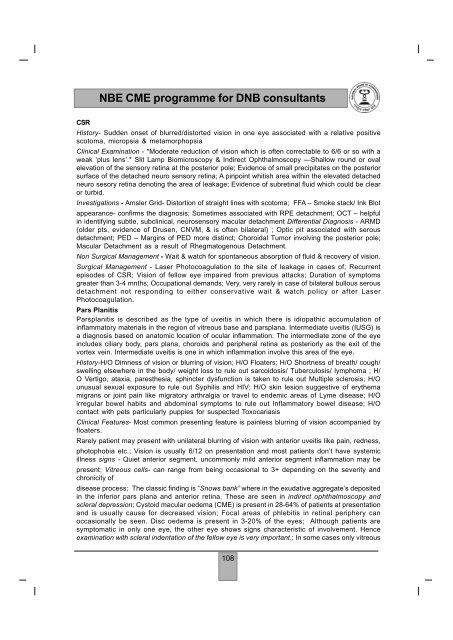NBE CME programme for DNB consultants - National Board Of ...
NBE CME programme for DNB consultants - National Board Of ...
NBE CME programme for DNB consultants - National Board Of ...
You also want an ePaper? Increase the reach of your titles
YUMPU automatically turns print PDFs into web optimized ePapers that Google loves.
<strong>NBE</strong> <strong>CME</strong> <strong>programme</strong> <strong>for</strong> <strong>DNB</strong> <strong>consultants</strong>CSRHistory- Sudden onset of blurred/distorted vision in one eye associated with a relative positivescotoma, micropsia & metamorphopsiaClinical Examination - *Moderate reduction of vision which is often correctable to 6/6 or so with aweak ‘plus lens’.* Slit Lamp Biomicroscopy & Indirect Ophthalmoscopy —Shallow round or ovalelevation of the sensory retina at the posterior pole; Evidence of small precipitates on the posteriorsurface of the detached neuro sensory retina; A pinpoint whitish area within the elevated detachedneuro sesory retina denoting the area of leakage; Evidence of subretinal fluid which could be clearor turbid.Investigations - Amsler Grid- Distortion of straight lines with scotoma; FFA – Smoke stack/ Ink Blotappearance- confirms the diagnosis; Sometimes associated with RPE detachment; OCT – helpfulin identifying subtle, subclinical, neurosensory macular detachment Differential Diagnosis - ARMD(older pts, evidence of Drusen, CNVM, & is often bilateral) ; Optic pit associated with serousdetachment; PED – Margins of PED more distinct; Choroidal Tumor involving the posterior pole;Macular Detachment as a result of Rhegmatogenous Detachment.Non Surgical Management - Wait & watch <strong>for</strong> spontaneous absorption of fluid & recovery of vision.Surgical Management - Laser Photocoagulation to the site of leakage in cases of; Recurrentepisodes of CSR; Vision of fellow eye impaired from previous attacks; Duration of symptomsgreater than 3-4 mnths; Occupational demands; Very, very rarely in case of bilateral bullous serousdetachment not responding to either conservative wait & watch policy or after LaserPhotocoagulation.Pars PlanitisParsplanitis is described as the type of uveitis in which there is idiopathic accumulation ofinflammatory materials in the region of vitreous base and parsplana. Intermediate uveitis (IUSG) isa diagnosis based on anatomic location of ocular inflammation. The intermediate zone of the eyeincludes ciliary body, pars plana, choroids and peripheral retina as posteriorly as the exit of thevortex vein. Intermediate uveitis is one in which inflammation involve this area of the eye.History-H/O Dimness of vision or blurring of vision; H/O Floaters; H/O Shortness of breath/ cough/swelling elsewhere in the body/ weight loss to rule out sarcoidosis/ Tuberculosis/ lymphoma ; H/O Vertigo, ataxia, paresthesia, sphincter dysfunction is taken to rule out Multiple sclerosis; H/Ounusual sexual exposure to rule out Syphilis and HIV; H/O skin lesion suggestive of erythemamigrans or joint pain like migratory arthralgia or travel to endemic areas of Lyme disease; H/Oirregular bowel habits and abdominal symptoms to rule out Inflammatory bowel disease; H/Ocontact with pets particularly puppies <strong>for</strong> suspected ToxocariasisClinical Features- Most common presenting feature is painless blurring of vision accompanied byfloaters.Rarely patient may present with unilateral blurring of vision with anterior uveitis like pain, redness,photophobia etc.; Vision is usually 6/12 on presentation and most patients don’t have systemicillness signs - Quiet anterior segment, uncommonly mild anterior segment inflammation may bepresent; Vitreous cells- can range from being occasional to 3+ depending on the severity andchronicity ofdisease process; The classic finding is “Snows bank” where in the exudative aggregate’s depositedin the inferior pars plana and anterior retina. These are seen in indirect ophthalmoscopy andscleral depression; Cystoid macular oedema (<strong>CME</strong>) is present in 28-64% of patients at presentationand is usually cause <strong>for</strong> decreased vision; Focal areas of phlebitis in retinal periphery canoccasionally be seen. Disc oedema is present in 3-20% of the eyes; Although patients aresymptomatic in only one eye, the other eye shows signs characteristic of involvement. Henceexamination with scleral indentation of the fellow eye is very important.; In some cases only vitreous108
















